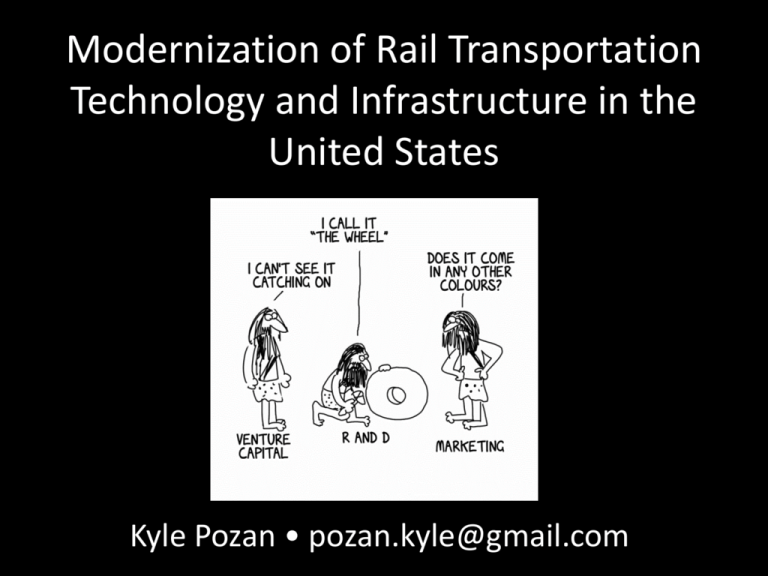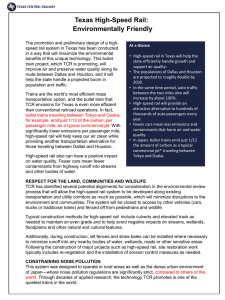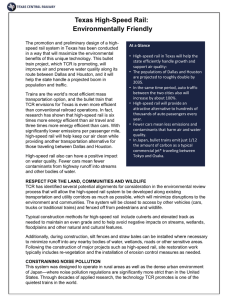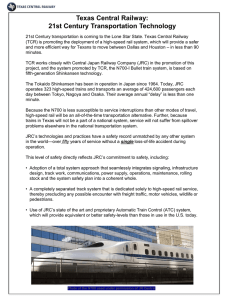A Comprehensive Review of the Various Proposed Forms of
advertisement

Modernization of Rail Transportation Technology and Infrastructure in the United States Kyle Pozan • pozan.kyle@gmail.com Overview • A brief history of transportation in the United States. • A case for railroad regulation reform and the implementation of high-speed rail. – Current U.S. rail network. – Future U.S. Rail Plans • Potential Barriers to the Successful Development of a High-Speed Rail Network – Conventional high-speed rail. – Maglev rail transportation. History of Transportation in the United States • The railroad revolutionized transportation in the United States. • Land grants and government subsidies allowed for the rapid expansion of rail transport in the U.S. • 2,000 miles of track were laid by 1840; 30,000 miles of track by the Civil War; 70,000 miles of track were laid in the 1880s alone. • By 1910, rail travel accounted for 95% of all intercity transportation. • In the 1920s, trains carried 1.2 billion passengers annually. • However, by the early 1930s, automobile travel had begun to make inroads in the rail passenger market. • Today, freight trains dominate the U.S. rail system. The Birth of the Automobile • At the turn of the 20th century, the automobile was poised to change the face of transportation in the United States. • By 1910, over 200 automobile manufacturers were incorporated in the United States. • Aided by the Interstate Highway System under the Federal-Aid Highway Act of 1956, the automobile lead to mobility on a scale formerly unknown, playing a major role in urban sprawl. The Rise of the Airline Industry • Like the Interstate Highway System, the airline industry has shrunk the vast distance that separates the Eastern and Western borders of the United States. • The The Civil Aeronautics Act of 1938 created the Civil Aeronautics Board, an organization authorized to oversee the airline industry. • Airline transportation took off when Congress deregulated the airline industry in 1978. Current Methods of Transit and Their Respective Issues • Currently, the three principal methods of transportation in the United States are inextricably tied to petroleum. The U.S. Rail Network • Long-distance rail travel is not seen by many as a viable form of transportation in the United States. • While there are over 75 airlines in the U.S., only one major passenger rail company, Amtrak, is currently in operation. – Amtrak is federally owned. – Private investment in railroads is almost nonexistent. Amtrak • The National Railroad Passenger Corporation, d/b/a Amtrak, is a government-owned intercity passenger rail service. • Amtrak service includes over 500 destinations. • Amtrak is considered to be one of the most energy-efficient forms of transportation. • There is ample room for improvement, however. • Criticisms of Amtrak – Seen as a bailout for corporate rail interests and union rail workers. – Criticized it as a waste of precious government funds. – Not a viable form of mass transportation. • The Acela has been a success, serving over 8,000 riders per day. • The Acela, however, operates at an average speed of 70 mph and is subject to numerous federal regulations that hamper its expansion. – It’s route is limited to the Northeastern Corridor. • Many criticism, however, are based on comparisons with European and Asian rail service. – A majority of passenger trains in the U.S. have a maximum operating speed of 79 mph., with the Acela being a notable exception. – U.S. trains are not as energy efficient as their European and Asian counterparts. High-Speed Rail Projects • In January, President Obama announced an $8 billion award to states for the development of 13 new, large-scale high-speed rail corridors.1 – It is the largest investment in infrastructure since the Interstate Highway System was created under Eisenhower. • The plan also includes $1 billion annual allotment in the federal budget. – Allocations to continue annually for 5 years. 1 White House Press Release (Jan. 28, 2010). Proposed High-Speed Corridors Not Up To European Standards • The two largest projects will see maximum speeds of 110 mph.2 – High-speed trains in Europe and Asia travel at an average speed of 120 mph and can exceed 215 mph. • Planning studies for additional service enhancements are included in the budget. • A majority of the budget will be spent on improvements rather than new construction.3 – Station renovations. – Bridge expansions. – Overhaul of signal systems. 2 3 Id. Id. • Funds will not be spent on dedicated tracks that would require a separate right of way. – This would be required for true high-speed rail. • Will likely be subject to stringent federal regulations. Japan Case Study • Benefits of high-speed rail are obvious in Japan. • By 1994, the high-speed line from Tokyo to Osaka accounted for 80% of the travel between the two cities.4 – By car, they journey is 7 hours. – The same trip is only 3 hours via high-speed rail. 4 Hiroshi Okada, Features and Economic and Social Effects of the Shinkansen. Japan Railway & Transport Review (1994). • Time saved from switching from a conventional to highspeed rail network is approximated at 400 million hours. – The value of the time saved is $6 billion (U.S.)5 • The high-speed rail network is credited with rejuvenating rural towns. • Privatization saved Japan’s high-speed rail network from bankruptcy.6 5 Id. 6 Id. Overly Dependent • In 2009, the U.S. trade deficit was $380 billion.7 – More than half of the deficit, $204 billion, is oil related. – Automotive imports accounted for $79 billion. • A consistent trade deficit weakens the economy. 7 U.S. Census Bureau High-Speed Rail Technology • Two Approaches – Traditional High-Speed Rail Technology – Maglev Technology Conventional High-Speed Rail Technology • Standard gauge track. • No at-grade crossings. – Trains either travel above (via bridges) or below (via tunnels) automobile traffic. • Implementation of a traditional high-speed rail network would require dedicated rail lines. • Bridges and tunnels would be constructed. • Dedicated rail lines and at-grade requirements would therefore result in an infrastructure overhaul. • One major benefit of conventional high-speed rail is articulated train cars. • Articulated train cars share wheels and trucks. • They are, more or less, permanently attached. • Articulated cars provide for smoother rides, less vibration and the design reduces the likelihood of jackknifing. • Less wheels and trucks means less frequent maintenance. • Articulated cars allow for the train to tilt. Magnetic Levitation Trains • Conventional high-speed rail utilizes standard gauge rail, diesel engines and overhead electrified wires to propel trains. • Magnetic levitation, or “Maglev”, trains is a system that uses magnetic energy to suspend and propel trains. – No engine is required to pull cars down the track. – No fossil fuels are used. • The magnetized coil running along the track, called a guideway, repels the large magnets on the train's undercarriage. – This allows the train to levitate. • Wheels are used at slower speeds when the magnetic force is not strong enough to suspend the train. • There is no friction, allowing for an incredibly smooth ride at unprecedented speeds. • Magnetic energy used to propel the train can be recaptured when the train slows down. • “Tokyo's electric trains get 6,600 miles to the gallon.”8 • Constructing a high-speed rail system would result in 29 million fewer car trips and 500,000 fewer plane flights each year.9 – Results in an annual reduction of 6 billion pounds of carbon dioxide emissions. • A national high speed rail system will significantly reduce our dependence on cars and oil. – It would significantly reduce carbon emissions. • The electrical portion of the system can be powered by renewable energy. Thank you! 8 USA 9 Today (Mar. 4, 2008). Center for Clean Air Policy (2006).





